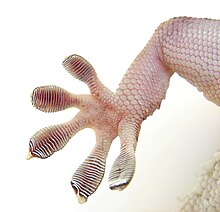تیغک (کالبدشناسی)

تیغکها در کالبدشناسی سطح عبارتند از ساختاری ورقه ای که در تعداد زیاد کنار هم قرار گرفتهاند و بین آنها فضای خالی است. علاوه بر کاربرد تنفسی در پالوده کردن غذا و کمک به بالا رفتن از سطوح صاف هم کاربرد دارند.[۱]
آبشش ماهی یک نمونه تیغک است.
منابع[ویرایش]
- ↑ Santos, Daniel; Matthew Spenko; Aaron Parness; Kim Sangbae; Mark Cutkosky (2007). "Directional adhesion for climbing: Theoretical and practical considerations". Journal of Adhesion Science and Technology. 21 (12–13): 1317–1341. doi:10.1163/156856107782328399.
Gecko "feet and toes are a hierarchical system of complex structures consisting of lamellae, setae, and spatulae. The distinguishing characteristics of the gecko adhesion system have been described [as] (1) anisotropic attachment, (2) high pulloff force to preload ratio, (3) low detachment force, (4) material independence, (5) self-cleaning, (6) anti-self sticking and (7) non-sticky default state. … The gecko’s adhesive structures are made from ß-keratin (modulus of elasticity [approx.] 2 GPa). Such a stiff material is not inherently sticky; however, because of the gecko adhesive’s hierarchical nature and extremely small distal features (spatulae are [approx.] 200 nm in size), the gecko’s foot is able to intimately conform to the surface and generate significant attraction using van der Waals forces.
